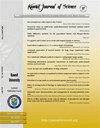利用空间工具探测 2020-2023 年期间伊拉克最频繁的沙尘暴来源
IF 1.1
4区 综合性期刊
Q3 MULTIDISCIPLINARY SCIENCES
引用次数: 0
摘要
沙尘暴是中东等干旱和半干旱地区的典型现象;近年来,伊拉克沙尘暴的频率和严重程度急剧增加。本文利用气象卫星旋转增强可见光和红外成像仪(SEVIRI)波段的遥感数据确定伊拉克的沙尘暴源。利用混合单粒子拉格朗日综合轨迹模型(HYSPLIT)提取的卫星图像和模拟锋面沙尘暴轨迹,确定了中东和伊拉克最具影响力的沙尘暴源。在 2020-2023 年期间伊拉克发生的 132 次沙尘暴中,春季和夏季最为频繁。使用 ArcGIS 软件生成了沙尘源频率百分比地图(DSFPM)。位于伊拉克、沙特阿拉伯、叙利亚和约旦的地区是最大的沙尘暴源。在伊拉克西南部和西部地区(如 Al-Nukhaib、Wadi Hauran 和 Sinjar)发现了新的沙尘源,在沙特阿拉伯、约旦和叙利亚也发现了新的沙尘源。最常见的沙尘暴源集中在伊拉克(55.31%),主要分布在底格里斯河和幼发拉底河流域、西部沙漠和半岛地区,其次是叙利亚(19.55%)、沙特阿拉伯(12.29%)和约旦(11.73%)。伊拉克沙尘暴源频率最高的地区是萨马瓦沙漠南部地区(27.37%)。此外,还确定了每个国家沙尘暴源的最高频率。了解沙尘暴的起源和轨迹将有助于更好地处理这些原因及其对该地区环境和社会经济造成的后果。它有助于支持区域专门机构缓解这一现象。本文章由计算机程序翻译,如有差异,请以英文原文为准。
Detection of the most frequent sources of dust storms in Iraq during 2020–2023 using space tools
Dust storms are typical in arid and semi-arid regions such as the Middle East; the frequency and severity of dust storms have grown dramatically in Iraq in recent years. This paper identifies the dust storm sources in Iraq using remotely sensed data from Meteosat-spinning enhanced visible and infrared imager (SEVIRI) bands. Extracted combined satellite images and simulated frontal dust storm trajectories, using the Hybrid Single Particle Lagrangian Integrated Trajectory (HYSPLIT) model, are used to identify the most influential sources in the Middle East and Iraq. Out of 132 dust storms in Iraq during 2020–2023, the most frequent occurred in the spring and summer. A dust source frequency percentage map (DSFPM) is generated using ArcGIS software. The regions located in Iraq, Saudi Arabia, Syria, and Jordan are the largest dust storm sources. New dust sources are identified in Iraq's southwestern and western regions, such as Al-Nukhaib, Wadi Hauran, and Sinjar, along with new sources in Saudi Arabia, Jordan, and Syria. The most common sources are concentrated in Iraq (55.31%), mainly in the Tigris and Euphrates basin, western desert, and Al-Jazeera region, followed by Syria (19.55%), Saudi Arabia (12.29%), and Jordan (11.73%). The highest dust storm source frequency in Iraq is found in the Al-Samawa desert's southern region (27.37%). Also, the highest frequency of dust sources from each country is determined. Knowing the origins and trajectories of dust storms will enhance treatments of these causes and their consequences on the environment and socio-economics of the region. It contributes to the support of specialised regional agencies to mitigate this phenomenon.
求助全文
通过发布文献求助,成功后即可免费获取论文全文。
去求助
来源期刊

Kuwait Journal of Science
MULTIDISCIPLINARY SCIENCES-
CiteScore
1.60
自引率
28.60%
发文量
132
期刊介绍:
Kuwait Journal of Science (KJS) is indexed and abstracted by major publishing houses such as Chemical Abstract, Science Citation Index, Current contents, Mathematics Abstract, Micribiological Abstracts etc. KJS publishes peer-review articles in various fields of Science including Mathematics, Computer Science, Physics, Statistics, Biology, Chemistry and Earth & Environmental Sciences. In addition, it also aims to bring the results of scientific research carried out under a variety of intellectual traditions and organizations to the attention of specialized scholarly readership. As such, the publisher expects the submission of original manuscripts which contain analysis and solutions about important theoretical, empirical and normative issues.
 求助内容:
求助内容: 应助结果提醒方式:
应助结果提醒方式:


